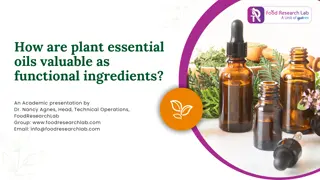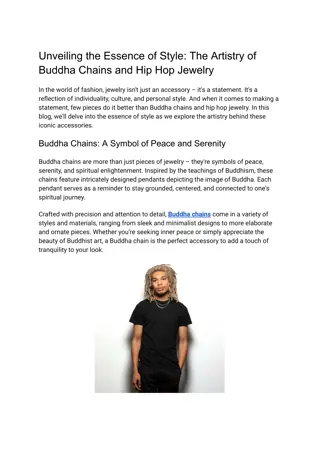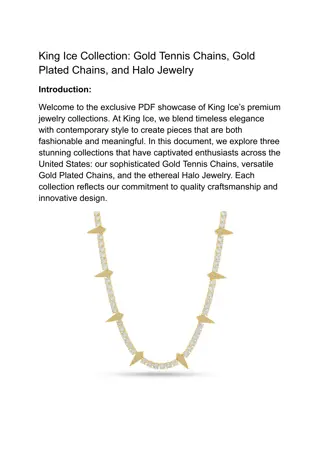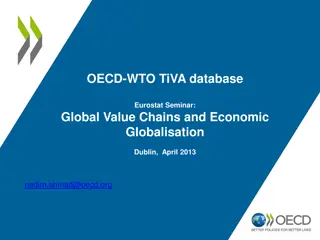Exploring Food Chains: Does Matter Disappear Along the Way?
In this lesson on food chains, students investigate whether matter disappears as it moves from one organism to another. Using a linking-cube simulation, they track food molecules mathematically to determine if any matter is lost in the process. The lesson involves hands-on activities and observations to help students understand the flow of matter in a food chain and its implications.
Download Presentation

Please find below an Image/Link to download the presentation.
The content on the website is provided AS IS for your information and personal use only. It may not be sold, licensed, or shared on other websites without obtaining consent from the author. Download presentation by click this link. If you encounter any issues during the download, it is possible that the publisher has removed the file from their server.
E N D
Presentation Transcript
FOOD WEBS LESSON 4B As Matter Moves from Organism to Organism in a Food Chain, Does Any of the Matter Disappear? What Is Your Evidence?
Focus Question from Last Time What happens to matter as it moves from organism to organism in a food chain? What did you say about the different things that might happen to the food matter in a worm when a bird eats it? Photo courtesy of Pixabay.com
Todays Focus Questions As matter moves from organism to organism in a food chain, does any of the matter disappear? What is your evidence?
Does Matter Disappear? Today we ll repeat our linking-cube simulation to show how food molecules move from organism to organism in a food chain. But this time, we ll track the matter mathematically to see whether any of it disappears!
What the Linking Cubes Represent Last time we used linking cubes to show what happens as matter moves from one organism to another in a food chain. What did the linking cubes represent?
Tracking Matter in a Food Chain What does the handout title and the text underneath tell you? What is shown in column 1 on the left side of the chart? What is shown in column 2? What do you think the next 4 columns will show?
Matter at the Start Make sure you have your organism posters/mats and linking cubes. (Remember what the cubes represent!) You should have 72 linking cubes, or atoms, at the start. Write that number at the top of your handout.
Matter at the Start Count the number of carbon-dioxide (CO2 ) molecules we re starting with. What fraction of the total number of cubes do the CO2 molecules represent? Write that fraction on your chart (row 1, column 3).
Matter at the Start Next, count the number of water (H2O) molecules we re starting with. What fraction of the total number of cubes do the H2O molecules represent? Write that fraction on your chart (row 2, column 3).
Matter at the Start How can we figure out the total amount of matter we have at the start? Be sure to write the number as a fraction on your chart. What is the denominator always going to be and why? How many cubes (pieces of matter) are we starting with?
What Will Happen to the Matter? What did we do with the CO2 and H2O molecules in our last lesson? Let s see what will happen to our 72 cubes of matter
Show the Tree Making Food and Growing Use up all your carbon-dioxide and water molecules showing how the tree makes food matter. Put leftover oxygen pieces (atoms) in the bowl labeled Oxygen (or in the air around the tree). Show how the tree grows bigger as it uses the food molecules.
Lets Do the Math! How much matter do we have now? And where is it? Count the pieces of matter (atoms) and record the data as a fraction in column 4 of your chart. Then add up the total amount of matter and record that at the bottom.
Other Uses for the Food Molecules What else can the tree do with the food molecules besides using them to grow? What else do food molecules contain besides matter? The tree needs energy to live, so it breaks down the food molecules to release the stored energy. Break apart four food molecules (linking cubes). The clicking sound you hear represents energy being released. The tree uses this energy to live. But what happens to the leftover pieces of matter?
What Happens to the Leftovers? In nature, the leftover pieces of matter immediately start matching up to make CO2 and H2O molecules. So use your leftover pieces to make as many CO2 and H2O molecules as you can. If you need more oxygen molecules, take them from the oxygen bowl (or from the air around the tree). Put your new CO2 and H2O molecules in their labeled bowls.
Other Uses for the Food Molecules What else can the tree do with the food molecules it made? Some of the matter can fall to the ground as wastes like when leaves, branches, berries, or nuts fall to the ground. So drop one food molecule into the bowl labeled Wastes.
What Else Happens to the Food Matter? It gets passed on to another organism! So move nine food molecules from the tree to the squirrel. What does this matter help the squirrel do? Grow bigger!
Lets Do the Math Again! How much matter do we have now? And where is it? Count the pieces of matter (atoms) and record the data as a fraction in column 5 of your chart. Then add up the total amount of matter and record that number at the bottom.
Other Uses for the Food Molecules What else can the squirrel do with the food matter? Just like the tree, the squirrel uses food matter for energy! So take apart twoof the squirrel s food molecules to release energy. What do you think you should do with the leftover pieces of matter? Yes! Make CO2 and H2O molecules and put them in the appropriate bowls.
Other Uses for the Food Molecules What else can the squirrel do with the food molecules? It leaves wastes on the ground! So take one food molecule and put it in the bowl labeled Wastes.
What Else Happens to the Food Matter? One day a mountain lion eats part of the squirrel. So move five food molecules from the squirrel to the mountain lion.
Other Uses for the Food Molecules What else can the mountain lion do with the food matter? Just like the tree and the squirrel, the mountain lion uses the food matter for energy! So take apart twoof the mountain lion s food molecules to release energy. What do you think you should do with the leftover pieces of matter? Yes! Make CO2 and H2O molecules and put them in the appropriate bowls.
Other Uses for the Food Molecules What else can the mountain lion do with the food molecules? It leaves wastes on the ground. So take one food molecule and put it in the bowl labeled Wastes. Could the mountain lion pass on food molecules to other organisms?
Lets Do the Math Again! How much matter do we have now? Where is it? Count the pieces of matter (atoms) and record the data as a fraction in column 6 of your chart. Then add up the total amount of matter and record that number at the bottom.
Look for Patterns in the Data Work in your small groups to identify patterns in your data. What do you notice? What happened to the matter? Be ready to share your observations.
Explaining the Data Today s focus questions: As matter moves from organism to organism in a food chain, does any of the matter disappear? What is your evidence? Answer these questions in your notebooks. Make a claim and provide evidence based on the data from your charts. Use these sentence starters: My claim is My evidence is
Explaining the Data: Your Claims and Evidence Science Presenters Science Listeners What do you mean? My claim is I agree because I disagree because My evidence is I want to add on I want to piggyback
Lets Summarize! Today s focus questions: As matter moves from organism to organism in a food chain, does any of the matter disappear? What is your evidence? What we found out: Atoms can be rearranged to form different kinds of molecules, and atoms and molecules can move from organism to organism. But atoms and molecules don t disappear. We showed this by counting the cubes (atoms). The amount of matter (the number of cubes) in the food chain always stayed the same: 72! A big idea: Matter can never disappear or be destroyed!
Todays Focus Questions As matter moves from organism to organism in a food chain, does any of the matter disappear? What is your evidence?
Next Time Tomorrow we ll explore these questions: What happens to the waste matter that the tree, the squirrel, and the mountain lion left behind? What happens to dead organisms?























